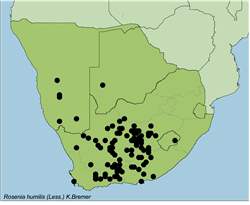Names and synonyms
Rosenia humilis (Less.) Bremer=Nestlera humilis Lessing =Relhania dichotoma Willd. ex Less.=Polychaetia relhanioides Lessing =Relhania linifolia Willd. ex Less.=Nestlera minuta auct. =Nestlera oppositifolia DC. =Nestlera rigida DC. =Nestlera muriculata DC. =Nestlera conferta DC. =Relhania dumosa E. Mey. ex DC.=Nestlera dinteri Muschl. ex Dinter=Rosenia nestleroides Compton =Nestlera rosenioides Hutchinson ex Compton=Nestlera incana Dinter ex Merxm.
Type
Bolus, H. 12089, Oudsthoorn, 1905 (BOL, PRE, MO, K)
Common names
Blouperde-karoo, Hartebeeskaroo, Perdekaroo, Bekkerbossie, Gemsbok-karoo, Perdekool, Volstruisbossie, Volstruiskaroo, Perdebossie, Springbok-karoo
Derivation of names
Rosenia = after E. Rosen (1714-1796), Swedish physician, botanist and professor of practical medicine.humilis = low-growing, dwarf
Diagnostic characters
Dry capitula of previous season often persistent during the following flowering seasonLeaves often glandular, glands multicellular with a broad base and narrow tipCypselas always with a basal tuft of hairs
Description
Very variable, hardy compact or diffuse, often vigorous shrubs, 0.2-0.4 m tall, densely and generally subdichotomously branched, occasionally somewhat spiny. Stems woody and grey to greyish-white, with remnants of old capitula persistent for a few seasons. Leaves grey-hairy, often with a bluish tinge, up to 1-20 x 0.4-2 mm, linear to obovate, flat, half-round or three-sided, with margins sometimes involute, often glandular with stalked glands. Capitula about 20 mm in diameter, florets yellow, buds golden-brown to dark brown, sticky when green. Involucre urn-, cup- or bell-shaped, 2-11 mm wide. Involucral bracts 10-55, to 9 x 3 mm, golden-brown, without translucent margins, outer ovate, inner gradually longer, oblong to spatulate. Receptacle epaleate or occasionally paleate, with paleae up to 8 mm long. Ray florets 5-22, lamina 3.5-13 mm long. Disc florets 5-40, corolla 3.6-7.3 mm long. Cypsela almost circular in cross section, oblong, 2-4.8 x 0.5-1.2 mm, always with a basal tuft of hairs, otherwise glabrous or � sparsely pilose, basally transversely conspicuously rugose, often with a thickened rim apically below pappus. Pappus an irregularly and minutely toothed crown of short scales, up to 1.5 mm long, often also with 1-3, smooth or barbellate bristles, up to 6 mm long.
Flowering time
Mainly from August to October.
Distribution
The distribution of R. humilis reflects the distribution of the whole genus. It is widespread throughout the arid areas of southern Africa and occurs in southern or southwestern Botswana, southern Namibia, and in the karoo areas of the Cape and in the southern Free State. Known from more than 330 specimens.
Habitat
On flats in partially moist or partially dried-up areas such as vleis and pans, on ridges and mountain slopes. It often grows in stony ground, it is usually found on sandy, shaly or clayey karoo flats and mostly in clayey soils.
Notes
At first glance this species seem to have a very broad concept, is very variable and probably consist of several species. However, the complex should be investigated to determine if different species can be distinguished. The leaf glands in the other species are quite distinctive, but there are specimens identified as R. humilis, which posess the types of leaf glands of R. oppositifolia, R. glandulosa and R. spinescens. Above all an unique type of gland (multicellular with a broad base and fine tip) occurs in R. humilis and could possibly provide a solution to clearly identify different species.This species is very drought resistant, and although it is not very palatable it provides feed when most other plants have been grazed. New growth is pleasantly aromatic.
References
BREMER, K. 1976. The genus Rosenia (Compositae). Botaniska Notiser 129: 97-111. GLEN, H.F. 2004. SAPPI, What's in a Name? The Meanings of the Botanical Names of Trees. Jacana.POWRIE, L. 2004.Common names of Karoo Plants. Strelitzia 16. National Botanical Institute.SHEARING, D. 1994. Karoo. South African Wild Flower Guide 6. Botanical Society of South Africa.VLOK, J. & SCHUTTE-VLOK, A L. 2010. Plants of the Klein Karoo. Umdaus Press

_sml.jpg)
_sml.jpg)
_sml.jpg)
_sml.jpg)
_sml.jpg)
_sml.jpg)